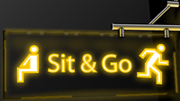For many professional poker players, Sit & Go’s are their preferred main source of income. This is due to a lower variance factor compared to cash games, as well as more flexible time commitments since a game can go from start to finish in under an hour. With smart play, a good player can grind out consistent profits.

Early Stages
The early stages of a Sit & Go can be quite chaotic as fishy players will try to be very aggressive with their chips. Here’s some general guidelines that you should keep track off:
- To maximize your profits, it’s well advised to start off with extremely tight play and only get involved in big pre-flop pots with premium hands.
- When you do get a big hand, play it aggressively pre-flop to minimize the number of callers. The more players in the pot, the more vulnerable a single pair will be.
- Be very careful playing tricky hands, like AK or AQ, if you don’t hit the flop as many bad players will call you down with any pair. Keep bluffing to a minimum unless you’re positive your opponent will fold.
- If you see some players build up huge stack sizes quickly, don’t feel pressured to make unnecessary risks. It’s not until the later stages of the match where your chip stack size will matter – in fact you could potentially fold all hands during the first few blind levels and still have enough chips to be a threat.
- Keep track of all your opponent’s playing styles as play progresses. These notes will be critical in the late stages of the game where separating the rocks from the calling stations can mean all the difference in your profits.
Middle Stages
The middle stages of a Sit & Go usually start around the fourth blind level and it’s at this point you should have a tight table image that you can use to your advantage to steal the more valuable blinds.
- Start getting involved in more hands and always raise in late position when folded to you.
- Continuation bets should now become more frequent – especially against the weaker players at your table.
- Make opponents pay for any flops you connect with that have obvious potentials for draws. (ie connected cards or flush potentials)
- If there are any passive players remaining, make an occasional 3-bet against them, providing they aren’t so short stacked that a call is forced.
- If approaching the prize pool bubble, use the fear of busting before the money to your advantage by looking for good spots to all-in semi-bluff your monster draws.
Late Stages
The late stages of a Sit & Go consist of breaking into the top three and a share of the prize pool. The blinds will usually be large enough that some players will be pressured by their short stacks to make bold moves.
- If the money has yet to break, this is where you will need to be the most aggressive by increasing your frequency of raising or re-raising. Many players will be afraid to bust out so fold expectations will be very high.
- Don’t let the blinds catch up to you: if you have less then 10 big blinds, starting pushing all-in pre-flop with any decent hand.
- When playing the big stack, respect the big raises but pounce on any players that constantly limp with squeeze plays. (ie. raising by at least current value of the pot.)
When you reach heads-up, continue with the strong aggression by raising at least 70% of the time you’re dealer.
